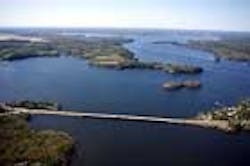EPA Proposes Permit to Improve Great Bay Estuary Health
The U.S. Environmental Protection Agency (EPA) is taking steps to restore and protect water quality in the Squamscott River and the Great Bay Estuary in New Hampshire. Specifically, EPA is proposing a draft discharge permit for the Exeter Wastewater Treatment Plant that includes protective limits for nitrogen discharges.
Studies performed by the New Hampshire Department of Environmental Services (NHDES) and the Piscataqua Region Estuaries Partnership have documented increased loadings of nitrogen to the Great Bay Estuary and its tributaries. The increased nitrogen concentrations in the Great Bay Estuary have resulted in increases in algal blooms, total suspended solids and low dissolved oxygen.
As nitrogen levels have increased, eelgrass beds have been lost in many parts of the Great Bay Estuary, and remaining eelgrass beds are declining. Eelgrass is recognized as one of the most highly productive and biologically diverse habitats on earth. Eelgrass is an important part of this estuarine ecosystem because it provides spawning and nursery habitat for many aquatic species, including commercially valuable fish and shellfish.
Due to increasing nitrogen loads and associated impacts, significant portions of the Great Bay Estuary, including the Squamscott River, have been included on New Hampshire’s list of impaired waters.
EPA will accept comments from the public on this proposal for 120 days, and will hold a public meeting June 9 at 6:30 p.m. at Exeter Town Hall to provide further information and answer questions on the draft permit. Immediately following the public meeting, a public hearing will be held at the same location to accept both oral and written comments on the proposed nitrogen limitations.
The Exeter Wastewater Treatment facility will require an upgrade in order to achieve the new discharge limitations. EPA is moving forward with the new draft permit recognizing that EPA and NHDES will need to work closely with the town to fully consider affordability issues and establish a reasonable compliance schedule.
EPA also recognizes that the control of nitrogen from the Exeter Wastewater Treatment Plant alone will not restore water quality in the Squamscott River and the Great Bay Estuary. Nitrogen reductions at all municipal wastewater treatment plants discharging to the Great Bay Estuary watershed, in addition to significant reductions in storm water runoff and contributions from septic systems will be necessary to restore water quality within the estuary. EPA intends to prepare draft permits and notices for other Great Bay Estuary wastewater treatment plants in a phased manner over the next three years, and to work closely with stakeholders to develop and implement management plans for the control of other contributing sources.
Source: Environmental Expert
